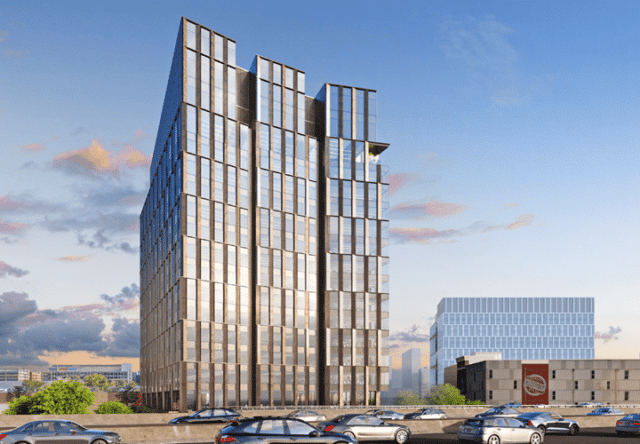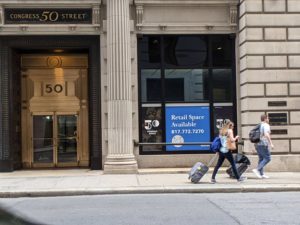After continuing to ascend driven by life science industry momentum through the early stages of the COVID era, Greater Boston’s commercial real estate industry felt the gravitational pull of financial markets’ tighter lending standards and industry layoffs in 2022.
Rising vacancies in office and lab properties gave tenants more leverage and prompted landlords to build out scores of spec lab suites, sparing increasingly cash-strapped biotechs the cost of buildouts. Multifamily development felt headwinds from the rising costs of materials and labor, while new hotel development remained on hold. Small retailers will get to compete for $9 million in grants from the city of Boston to subsidize rent and tenant buildouts, in a new program designed to fill gaps in the retail landscape, particularly downtown.
A Bust for Lab Development, or Just a Breather?
Lab development in Greater Boston is no longer the uncontested slam dunk that it’s been in recent years, when many speculative projects leased up most of their space before completion.
For most of the past decade, the supply-and-demand equation for life science space tilted sharply in developers’ favor, as projects spread from historical lab clusters in Cambridge and Lexington into Boston, Watertown, Waltham and Somervile. COVID-19 turbocharged the Boston’s life science real estate market, as venture capitalists poured over $14 billion into Greater Boston biotechs in 2021 alone. Bay State firms landed another $5.1 billion in venture funding during the first half of 2022, according to MassBIO.
Developers and their financial partners responded by breaking ground on major speculative projects during the first half of the year, including Boston Global Investors’ $530 million 10 World Trade tower in the Seaport District and Greystar’s 465,000-square-foot 74M tower in Somerville’s Assembly Square.
But the financing and investment climate changed rapidly in the fall following a series of Federal Reserve interest rate hikes, depressing life science investment. Biotechs listed nearly 2 million square feet of sublease space in the urban core this year, approximately half of which has been committed, according to JLL. Biogen alone offered more than 263,000 square feet in Kendall Square and Weston.
Citing construction cost escalation, Wellesley-based Mark Development said it was delaying its 1 million-square-foot Riverside lab project in Newton and seeking a two-year extension of its August 2023 deadline to ground-lease the 13-acre property from the MBTA.
As of December, JLL was tracking over 6 million square feet of lab development in the two-year pipeline and just 1.9 million square feet of active requirements. And even tenants still in the market are wary of paying increased construction costs for interior fitouts, prompting developers to build out 1.2 million square feet of spec suites at their own expense.
Some early-stage life science development proposals could be replaced by multifamily housing, according to Gary Kerr, managing director for Greystar’s Northeast region.
“Potentially it may be the way to go with the changing interest rate and debt environment. High-cost speculative developments like life science have become more difficult to get financed and built,” Kerr said.

Greystar’s 465,000-square-foot 74M office-lab tower on Middlesex Avenue in Somerville is pursuing a multi-tenant leasing strategy after breaking ground in June. Life science companies are in the market for approximately 1.9 million square feet of lab space in Greater Boston, according to brokerage research. Image courtesy of Elkus Manfredi Architects
Office Market Awaits Year of Reckoning
Office vacancies hit their highest levels since the Great Recession in 2022 and some landlords could face a make-or-break year in 2023 with record lease expirations coming due.
Direct vacancies ranged from 11.6 percent in Cambridge to 14.3 percent in Boston and 15.7 percent in the suburbs, according to third-quarter data from brokerage Newmark.
Landlords already have been upping concessions such as tenant improvement allowances and free rent to increase leasing velocity, but the 173 million-square-foot Greater Boston office market had nearly 1.3 million square feet of negative absorption through the first three quarters.
A wave of office property foreclosures is unlikely in the near term, said Peter Bloomfield, New England practice lead at KPMG in Boston. Many of Boston’s largest office towers are owned by publicly-owned REITs or institutional investors who purchased them without debt, or by experienced operators.
“The banks don’t want to own these buildings. If their debt maturity rolls over, the banks will be working with the borrowers to try to work out a deal to keep the ownership in place,” Bloomfield said.
High-profile developments such as MP Boston’s Winthrop Square, the revamped One Post Office Square and soon-to-be-updated One Lincoln towers attracted significant leases.
But as leases expire, many large corporate tenants have renewed or relocated while taking 20 to 30 percent less space than pre-COVID, Bloomfield noted, placing more pressure on the overall market and class B building owners in particular.

The Wu administration is offering a variety of incentives to revive downtown Boston real estate, from a $9 million retail grant program to potential subsidies and density bonuses for office-to-housing conversions. Photo by James Sanna | Banker & Tradesman Staff
Solving the Housing Cost Conundrum
Acknowledging what could be a long-term decline in demand for office space in Boston, city officials announced a program giving developers incentives for office-to-housing conversions.
Consultants’ proposals were due Thursday for a $100,000 land-use study of strategies to catalyze residential conversions in a large portion of the core business district from North Station to the Massachusetts Turnpike. In November after a two-year hiatus, the Boston Planning & Development Agency resumed its PLAN: Downtown study which had been looking at allowing taller building heights in portions of Downtown Crossing, the Financial District, Chinatown and the Theater District.
New leadership at the State House and Boston City Hall has generally placed housing affordability on the front burner, citing the potential for Massachusetts to lose economic competitiveness with lower-cost states. Massachusetts median single-family home prices hit $530,000 in November, a 3.9 percent year-over-year increase, according to The Warren Group, publisher of Banker & Tradesman.
Boston Mayor Michelle Wu concluded her first year in office by proposing increases in affordable housing percentages in multifamily projects and higher fees on commercial developers, including doubling linkage fees for lab projects. Wu also reiterated her plans to submit a local home rule petition seeking legislative approval for rent stabilization in Boston.
Industry groups such as commercial developers’ organization NAIOP-MA and MassBIO said the timing is poor to place additional financial burdens on developers, who already are facing increasing borrowing and construction costs and could be forced to cancel future projects or look elsewhere.
Gov.-elect Maura Healey said she wants to prioritize housing in dispositions of surplus state properties, in a departure from the Baker administration’s track record.

Steve Adams
Hotels Fill Up, Await New Construction
The local hotel industry staged a strong recovery beginning in spring, as tourists returned to Massachusetts with willingness to pay higher room rates after two years of pent-up demand. But financing for new development projects remains largely out of reach, as lenders remain cautious about future demand for business and group travel markets.
Occupancy rates in 2021 averaged 71 percent in Boston and Cambridge, according to Pinnacle Advisory Group research, and room rates averaged $287 per night. Rates now exceed pre-pandemic levels, and a JLL survey ranked Boston behind just London and Tokyo among top targets by hotel investors.
While developers are pursuing new hotel projects in the North End, West End, Downtown Crossing and Back Bay, the prospects for construction financing remain challenging in the near term. Developers of recently approved projects such as 88 North Washington St. and 7-9 Hamilton Place are waiting for signs of cooling in the construction cost market in 2023, along with easing of construction and permanent financing rates.




 |
| 

